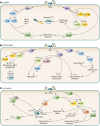Bacterial guanine nucleotide exchange factors SopE-like and WxxxE effectors
- PMID: 20123714
- PMCID: PMC2849395
- DOI: 10.1128/IAI.01250-09
Bacterial guanine nucleotide exchange factors SopE-like and WxxxE effectors
Abstract
Subversion of Rho family small GTPases, which control actin dynamics, is a common infection strategy used by bacterial pathogens. In particular, Salmonella enterica serovar Typhimurium, Shigella flexneri, enteropathogenic Escherichia coli (EPEC), and enterohemorrhagic Escherichia coli (EHEC) translocate type III secretion system (T3SS) effector proteins to modulate the Rho GTPases RhoA, Cdc42, and Rac1, which trigger formation of stress fibers, filopodia, and lamellipodia/ruffles, respectively. The Salmonella effector SopE is a guanine nucleotide exchange factor (GEF) that activates Rac1 and Cdc42, which induce "the trigger mechanism of cell entry." Based on a conserved Trp-xxx-Glu motif, the T3SS effector proteins IpgB1 and IpgB2 of Shigella, SifA and SifB of Salmonella, and Map of EPEC and EHEC were grouped together into a WxxxE family; recent studies identified the T3SS EPEC and EHEC effectors EspM and EspT as new family members. Recent structural and functional studies have shown that representatives of the WxxxE effectors share with SopE a 3-D fold and GEF activity. In this minireview, we summarize contemporary findings related to the SopE and WxxxE GEFs in the context of their role in subverting general host cell signaling pathways and infection.
Figures




Similar articles
-
The interplay between the Escherichia coli Rho guanine nucleotide exchange factor effectors and the mammalian RhoGEF inhibitor EspH.mBio. 2012 Jan 17;3(1):e00250-11. doi: 10.1128/mBio.00250-11. Print 2012. mBio. 2012. PMID: 22251971 Free PMC article.
-
EspT triggers formation of lamellipodia and membrane ruffles through activation of Rac-1 and Cdc42.Cell Microbiol. 2009 Feb;11(2):217-29. doi: 10.1111/j.1462-5822.2008.01248.x. Epub 2008 Oct 30. Cell Microbiol. 2009. PMID: 19016787 Free PMC article.
-
EspM2 is a RhoA guanine nucleotide exchange factor.Cell Microbiol. 2010 May 1;12(5):654-64. doi: 10.1111/j.1462-5822.2009.01423.x. Epub 2009 Dec 21. Cell Microbiol. 2010. PMID: 20039879 Free PMC article.
-
Mimicking GEFs: a common theme for bacterial pathogens.Cell Microbiol. 2012 Jan;14(1):10-8. doi: 10.1111/j.1462-5822.2011.01703.x. Epub 2011 Dec 1. Cell Microbiol. 2012. PMID: 21951829 Free PMC article. Review.
-
Enteropathogenic and enterohaemorrhagic Escherichia coli: even more subversive elements.Mol Microbiol. 2011 Jun;80(6):1420-38. doi: 10.1111/j.1365-2958.2011.07661.x. Epub 2011 May 5. Mol Microbiol. 2011. PMID: 21488979 Review.
Cited by
-
Recent insights into Pasteurella multocida toxin and other G-protein-modulating bacterial toxins.Future Microbiol. 2010 Aug;5(8):1185-201. doi: 10.2217/fmb.10.91. Future Microbiol. 2010. PMID: 20722598 Free PMC article. Review.
-
A protective epitope in type III effector YopE is a major CD8 T cell antigen during primary infection with Yersinia pseudotuberculosis.Infect Immun. 2012 Jan;80(1):206-14. doi: 10.1128/IAI.05971-11. Epub 2011 Nov 7. Infect Immun. 2012. PMID: 22064714 Free PMC article.
-
The Many Faces of IpaB.Front Cell Infect Microbiol. 2016 Feb 9;6:12. doi: 10.3389/fcimb.2016.00012. eCollection 2016. Front Cell Infect Microbiol. 2016. PMID: 26904511 Free PMC article. Review.
-
Interesting Biochemistries in the Structure and Function of Bacterial Effectors.Front Cell Infect Microbiol. 2021 Feb 24;11:608860. doi: 10.3389/fcimb.2021.608860. eCollection 2021. Front Cell Infect Microbiol. 2021. PMID: 33718265 Free PMC article. Review.
-
Deciphering the molecular and functional basis of Dbl family proteins: a novel systematic approach toward classification of selective activation of the Rho family proteins.J Biol Chem. 2013 Feb 8;288(6):4486-500. doi: 10.1074/jbc.M112.429746. Epub 2012 Dec 19. J Biol Chem. 2013. PMID: 23255595 Free PMC article.
References
-
- Alto, N. M., F. Shao, C. S. Lazar, R. L. Brost, G. Chua, S. Mattoo, S. A. McMahon, P. Ghosh, T. R. Hughes, C. Boone, and J. E. Dixon. 2006. Identification of a bacterial type III effector family with G protein mimicry functions. Cell 124:133-145. - PubMed
-
- Arbeloa, A., M. Blanco, F. C. Moreira, R. Bulgin, C. Lopez, G. Dahbi, J. E. Blanco, A. Mora, M. P. Alonso, R. C. Mamani, T. A. Gomes, J. Blanco, and G. Frankel. 2009. Distribution of espM and espT among enteropathogenic and enterohaemorrhagic Escherichia coli. J. Med. Microbiol. 58:988-995. - PMC - PubMed
Publication types
MeSH terms
Substances
Grants and funding
LinkOut - more resources
Full Text Sources
Research Materials
Miscellaneous

